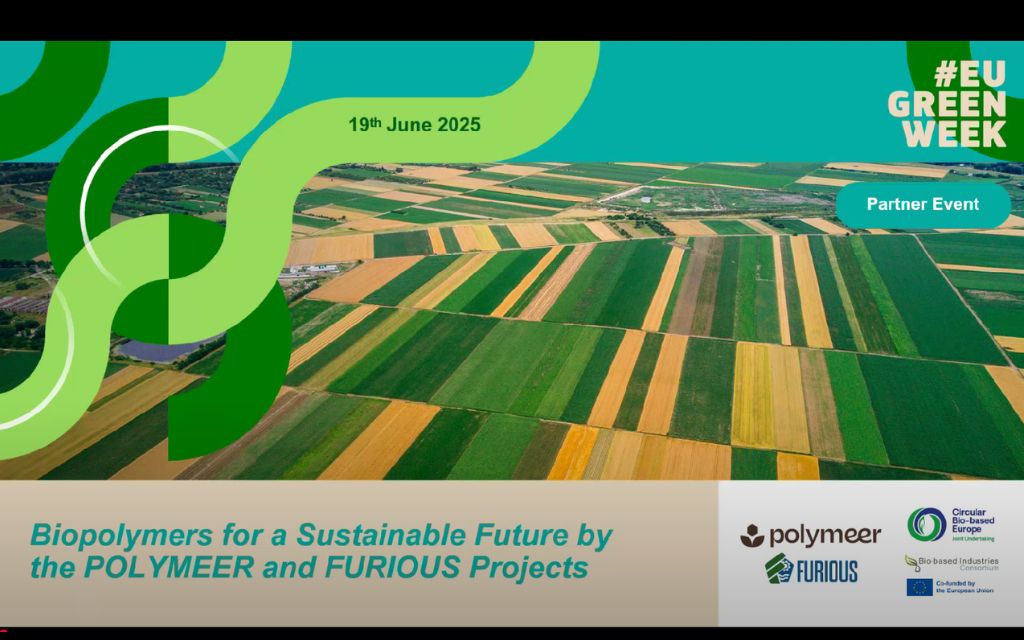Discover what was discussed at the event “Biopolymers for a Sustainable Future”, held by POLYMEER and FURIOUS on 19 June 2025.

As part of European Green Week, on 19 June 2025 the event “Biopolymers for a Sustainable Future” brought together researchers, industry leaders, and policymakers to explore how sustainable polymers can support Europe’s transition toward a circular economy.
Organized by the POLYMEER and FURIOUS projects, the webinar offered a forward-looking view of how renewable materials and waste valorization are driving a new generation of high-performance plastics.
Hosted online, the event featured two keynote speakers, Assunta Marrocchi (UNIPG) representing POLYMEER and Debora Puglia (UNIPG) from the FURIOUS project, followed by a roundtable discussion with Filip Miketa (BIO-MI), Nadia Lotti (UNIBO), and Daniele Spinelli (NTT).
From beer to bioplastics: the POLYMEER project
Opening the session, Assunta Marrocchi presented the vision behind the POLYMEER project, which was officially launched in September 2024. The initiative is dedicated to the development of sustainable polymers derived from brewer’s spent grain, or BSG. BSG, a byproduct of the beer industry, is produced in vast quantities across Europe, approximately 8 million tons per year, but remains underutilized, typically relegated to animal feed or discarded in landfills. POLYMEER aims to tap into this overlooked resource and convert it into valuable, bio-based materials for agriculture, packaging, and the automotive sector.
Marrocchi outlined the project’s systematic approach, starting with the green fractionation of BSG to isolate its main components, cellulose, proteins, and lignin. These are then processed using eco-friendly methods to create monomers, the essential building blocks for polymers. From there, the team designs materials that perform well during use but also integrate seamlessly into end-of-life pathways like recycling, composting, and biodegradation.
Marrocchi emphasized the project's broader objectives, which include converting at least 10 percent of Europe’s BSG output into bioplastics and encouraging adoption across more than 20 industries. The potential for impact is significant, not just in reducing plastic pollution but also in aligning with EU climate goals, creating green jobs, and raising public awareness about sustainable materials.
Giving sugars a second life: the FURIOUS project
Debora Puglia followed with insights into the FURIOUS project, which focuses on biopolymers based on FDCA, or furandicarboxylic acid. FDCA is a renewable monomer sourced from waste sugars and holds promise for a wide array of applications, from packaging and biomedical devices to underwater sensors and optical fibers. The challenge, Puglia explained, is achieving high purity in the monomers while balancing biodegradability and performance.
FURIOUS is advancing through green synthesis techniques, reactive blending for customized material properties, and gamma sterilization to make materials suitable for medical use. Their prototype films already demonstrate strong mechanical and barrier properties and are compatible with conventional plastic processing methods. This compatibility could ease the path to market adoption and reduce the cost of transition.
Challengs and opportunities for the bioplastics economy
The event concluded with a roundtable discussion featuring Filip Miketa, Nadia Lotti, and Daniele Spinelli, who explored the broader ecosystem challenges and opportunities. A recurring theme was the difficulty of scaling up. While lab results are promising, moving to industrial-scale production requires robust supply chains, stable access to feedstocks, and favourable regulatory frameworks. Cost competitiveness with fossil-based plastics remains a barrier, and market acceptance is not guaranteed without strong policy incentives and infrastructure support.
The panelists also stressed the importance of designing materials with their end-of-life in mind. Whether a product is intended to be recyclable, compostable, or biodegradable, it must integrate into existing waste management systems. This demands a shift not just in how materials are made, but in how they are used, recovered, and ultimately disposed of.
Towards a circular economy for biobased plastics
Throughout the webinar, the presenters highlighted the synergy between science, policy, and industry. Both POLYMEER and FURIOUS exemplify how innovation driven by sustainability goals can yield practical, high-performing alternatives to fossil-based materials. They also reflect a broader movement toward circularity, where waste becomes a resource, and design anticipates regeneration rather than disposal.
In conclusion, “Biopolymers for a Sustainable Future” served as both a showcase of cutting-edge research and a call to action. The transition to sustainable materials is not just a technological challenge but a systemic one that requires collaboration across disciplines and sectors. As Europe continues to pursue its Green Deal objectives, projects like POLYMEER and FURIOUS will play a vital role in building the foundation for a more sustainable, circular economy.